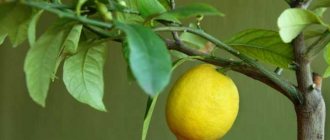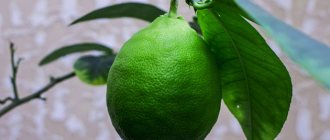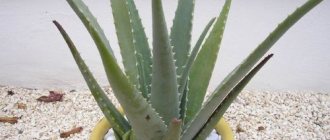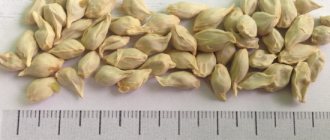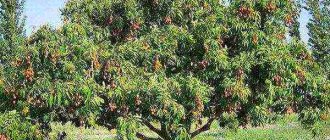Which lemon variety to choose for growing?
To successfully grow lemons, you first need to choose the right variety. Those of them that are used in open ground are too tall and will feel uncomfortable in an apartment. But breeders have developed varieties and hybrids of indoor lemons that are perfect for home greenhouses.
Among the most popular:
- Meyer;
- Pavlovsky;
- Novogruzinsky;
- Genoa;
- Lunario;
- Panderosa;
- Lisbon;
- Eureka;
- Anniversary.
Some of them are successfully grown both in open ground and at home, while others are intended exclusively for indoor cultivation. For example, the Pavlovsky variety is one of the most popular indoor lemons. It is perfectly adapted to home conditions, forgives some mistakes in care and is distinguished by good fruiting. If you don’t have enough experience, then you should start with Pavlovsk lemon.
We can say about Meyer lemon that it is a very productive hybrid with an interesting taste of the fruit. Panderosa is also a hybrid of lemon and citron - at home, a beautiful compact bush, which, however, is not distinguished by abundant fruiting. But Genoa is famous for both the excellent taste of the fruits themselves and their quantity on the tree, but it is quite capricious in care. In general, there is plenty to choose from.
Fertilizer
Lemons need to be fertilized systematically so that the plants grow healthy, bloom, and bear fruit. The roots of lemons grown in containers have a limited amount of soil from which they draw nutrients and microelements; frequent soil replacement is pointless and inconvenient.
It is impossible to successfully grow lemons in a pot without fertilizer, so it is important to know how to feed lemons at home. During watering, the soil in the pot is systematically washed and becomes poorer, so it should be supplemented with fertilizers so that the plants do not starve.
What fertilizer is best for homemade lemon?
These plants are heavy nitrogen users, especially larger trees during periods of strong growth. Therefore, fertilizers must contain a higher proportion of nitrogen compared to the other two main ingredients - phosphorus and potassium.
The N:P:K composition should have a ratio of 2:1:1 or at least 1:1:1 plus trace elements - iron, zinc, manganese.
There are several ready-made liquid lemon fertilizers on the market. In addition, slow-release mineral granules and organic fertilizers are used.
Main mineral components of fertilizers
| Component | Scope |
| Nitrogen | One of the most important minerals, involved in all metabolic processes. About 50% of the nitrogen absorbed by the plant accumulates in the leaves, the rest is distributed in the tree trunk, branches, and roots. Dark green leaves are the best indicator of the plant's nitrogen content and the amount of chlorophyll produced in the leaves. Adding nitrogen increases lemon fruiting. Excess nitrogen causes an increase in lush green mass, becomes the reason why it does not bloom, and fruiting is delayed. |
| Phosphorus | It is found in large quantities in the roots, and in the spring it is transported to the above-ground parts of the plant. There, in spring and summer, phosphorus is necessary for the formation of fruits. |
| Potassium | Plays an important role in shaping the quality of fruits, increasing the sugar content, aroma and smell. More than 40% of potassium is contained in fruits. It accumulates most in the summer because potassium is better absorbed in the hot months. |
| Magnesium and iron | They play an important role in the development of the plant. Participate in the synthesis of chlorophyll, an important factor in photosynthesis. A lack of iron results in yellowing of the leaves; the correct amount of iron ensures their green color. |
How and when to fertilize?
As citrus trees age, they need more fertilizer. It is better not to fertilize young lemons or apply smaller doses.
They begin to add nutrients when the plants wake up from winter rest and begin to grow, usually in March.
Then, depending on the type of fertilizer, the appropriate dose is applied throughout the growing season until the beginning of autumn.
Liquid fertilizer for citrus fruits
These are quite commonly used fertilizers. Before use, you need to dilute the concentrate in soft water in accordance with the instructions. Liquid fertilizers are applied under the lemon weekly. It’s worth using your intuition so as not to overload the plants.
Manufacturers of citrus liquid fertilizers include:
- Pokon,
- Agricola (Agrecol),
- Substral,
- Florovit.
Fertilizers in granules
This is also a popular way to apply fertilizer – especially slow-release fertilizer. Advantages of this fertilizer:
- Rare use - 2-3 times a year.
- The slow release of minerals prevents overfertilization even with deep watering.
The required amount of granules is scattered under the lemon trunk on the ground, then mixed with the top layer of soil.
Each watering releases nutrients that are absorbed by the plant's roots. Osmocote is a popular granular slow-release fertilizer also used for citrus fruits.
If the soil pH is too high, magnesium sulfate can be used.
Organic fertilizers
When growing lemons organically, you can use a diluted liquid infusion (preferably from young nettles), compost, organic osmocote, vermicompost.
Most fertilizers do not cause root burns, soil salinization, or general overfertilization. They are an excellent source of microelements - boron, zinc, copper, molybdenum.
Manure is one of the best organic fertilizers for growing citrus fruits.
Foliar feeding
In addition to traditional fertilizer, foliar feeding can be used - spraying with diluted liquid fertilizer.
The leaves very quickly absorb minerals from the drops of solution that settle on them. Foliar feeding is good if symptoms of deficiency of certain elements are detected on the leaves. This procedure can be carried out several times during the growing season.
Attention! Spraying is not carried out on sunny days or when the leaves of the plant are heated by the sun. It is better to do treatments in the evening or early in the morning.
Liquid fertilizer for foliar feeding should be used in low concentration, as recommended in the instructions, or even more diluted so as not to burn the leaves.
Plants are often sprayed with iron preparations because iron deficiency leads to chlorosis of lemon leaves.
Symptoms of Excess Fertilizer
Lemons that are over-fertilized grow just as poorly as lemons that are deficient in fertilizer. Excess minerals cause soil salinity, which is harmful to trees, especially lemon species such as Poncirus trifoliata.
The main symptoms of overfertilizing lemons are:
- yellowing, curling and falling of old, lower leaves;
- darkening of leaves - the appearance of brown spots;
- instead of white, the roots become brown or black - burning of the roots;
- sudden growth stop.
Improper fertilization of lemons causes great damage.
If such symptoms are observed, you need to rinse the soil several times or replace it with a new one, removing damaged roots and leaves.
The plant must have at least a month's break in the application of nutrients to allow the root system and leaves to recover.
Preparing the seed, soil and proper planting
You can grow a lemon tree yourself from cuttings or buy ready-made seedlings, but we will go the long way and plant a seed. If you cannot find a ripe fruit of the desired variety, you can take a store-bought one.
Lemon should be:
- quite large;
- ripe;
- correct shape;
- without mechanical damage and rot.
Before cutting the lemon and extracting the seeds, you need to prepare containers with soil, since the seeds should not have time to dry before sowing.
You can buy ready-made soil mixtures for citrus fruits in stores or mix them yourself. To do this, you need to take a universal flower soil and add peat to it in a 1:1 ratio, since lemons love slightly acidic soils. It is better to plant seeds in shallow boxes or small pots, for example, in disposable cups. It is necessary to place a high-quality drainage layer of expanded clay or broken brick at the bottom of the containers.
The seed should be planted immediately after it has been removed from the fruit. Even a slightly dried peel significantly reduces the percentage of seed germination, which is not very high for lemons anyway. Usually several seeds are planted at once in order to subsequently select the strongest seedlings. In order for the seeds to germinate better, it is recommended to soak them for 2-3 hours in water before planting. It activates the awakening process and increases the immunity of seedlings.
We plant the prepared seeds to a depth of about 1 centimeter in the soil and water them abundantly. Plantings can be covered with film or transparent containers. Usually the first shoots appear after 2-3 weeks. Until this point, you need to ensure that the container always contains moist, but not soggy soil. In microgreenhouses, as a rule, initial watering is sufficient until the sprouts appear. If, nevertheless, the substrate has dried out, then to moisten it it is advisable to use not a watering can, but a spray bottle.
It is convenient to plant seeds at the very end of winter, so that by the next growing season we will have a tree that can be grafted.
Lemon tree from cuttings
When planting a lemon tree, take a cutting about 8-10 cm long, on which a couple of leaves and several live buds are left. Before placing the cutting in the ground, it is advisable to treat its base with a root formation stimulator, for example Kornevin, after which it is planted in the soil to a depth of 3-4 centimeters and covered with a jar or bag. Until the cuttings have roots, it will need to be sprayed with water daily and the soil in which it takes root well moistened. Rooting occurs approximately a month to a month and a half after planting. It should be borne in mind that only some cuttings take root - this is to some extent a matter of luck. Next, the plant can be transplanted into a permanent pot.
Lemon from cuttings
When watering a lemon tree, you need to evenly moisten the earthen ball in the pot. Insufficient and uneven moisture can lead to drying out of the roots and their death. When the tree has grown enough and become strong, it will need a lot of sunlight. But lemons do not tolerate direct sunlight; it is better to choose a bright place for it, which receives diffused light. Lemon trees do not like constant moving from place to place. Every spring it must be replanted into a larger container. You can stop at a ten-liter container, regularly changing only the top layer of soil and actively fertilizing the plant.
Proper care will ensure flowering and fruiting of varietal lemons
During the heating season or dry summer, it is necessary to spray the plant daily to maintain the moisture it needs. To form a beautiful crown and produce lateral branches, the top of the tree must be trimmed from time to time. In order for lemon fruits to form on an adult tree, proper care and conditions must be provided. If there are too many fruits on the tree, it is better to remove some of them, as they will excessively deplete the plant.
Lemon seedling care
While our young lemons are not yet strong, they require constant attention. Mini-greenhouses must be removed periodically, increasing the hardening time of the plants. If they were planted in a common container, it is recommended to replant them no earlier than 3-4 true leaves appear. By this point, it will be possible to identify the strongest seedlings, which we will leave.
The sprouts, along with the root ball, are transferred into a new, larger container, and the voids are filled with fresh soil. In the future, transplantation of lemons at the age of 2-5 years is carried out annually in the spring before active growth begins. Older trees with mature crowns can be replanted every 2-3 years to renew the soil in pots.
Watering
Lemons love good watering and humidity, but do not tolerate stagnant moisture in pots. When there is a shortage of water, this citrus sheds leaves or already formed fruits, and when overwatered, the roots may rot. Therefore, you need to constantly monitor the condition of the soil. Ideally, it should easily stick together into a lump, but not get your hands dirty. In large and deep pots, especially with poor (insufficient or clogged) drainage, it is also possible that the soil is dry on top, but there is a lot of water in the deep layers. Therefore, it will be useful to periodically check the condition of the soil thickness using a dry long wood chip, a wooden stick or a special probe to measure soil moisture.
Water the plants with water at room temperature; if tap water is used, it must be filtered and settled. Watering is carried out along the edge of the pot, slowly saturating the entire volume. After the water appears in the pan, it is completely drained. Lemons also need periodic spraying of the leaves, not only in summer, but also in winter, when the air at home is too dry. The frequency of this procedure depends on the air humidity in the apartment.
Temperature
Lemon is a heat-loving crop. The range of optimal summer temperatures is between 22-25 degrees, winter temperatures - no lower than 20. The worst thing for lemon seedlings is cold drafts from the vents or coolness from window panes. Therefore, if you like to ventilate rooms in winter, you need to make sure that the pots do not stand on the windowsills at this time.
Lighting
Lemons need good lighting for at least 10 hours, even in winter. But you should not place the pot in the open sun - direct rays can burn the leaves. If your lemons are on the south side, then either move them deeper into the room or shade them with loose curtains. In order for the crowns of each tree to develop evenly, you need to periodically turn the pot with the opposite side towards the light source.
Top dressing
Both developing and fruiting lemons will require regular feeding. And the larger and older the tree becomes, the more volume it will need. They begin to feed the seedling at approximately two months of age. Use a specialized one for these purposes. It is suitable for plants of any age at all stages of the growing season. The fertilizer contains an NPK complex in ideal proportions for citrus fruits, microelements in chelated form, vitamins and a growth stimulator. That is, the tree is guaranteed to receive adequate nutrition and be healthy.
Fertilizing is applied in combination with watering once every 1-2 weeks in the summer, and in winter - once a month. But remontant varieties can be fed intensively in winter.
Lemon trimming
To form an optimal crown shape and improve branching, the lemon will need to be pruned regularly.
The main formative prunings on lemon trees are:
- in the first year, the crown bud is pinched when the seedling reaches a height of 20-30 cm;
- in the second year, 3-4 lateral skeletal shoots are left, and the rest are removed;
- in the third year, skeletal branches and shoots of the third order are shortened;
- in subsequent years it will be necessary to remove branches growing inside the crown, as well as diseased and deformed shoots.
Naturally, all pruning work must be carried out with a sterile instrument. It would be a shame if the results of several years of work were lost due to some disease included in the sections.
Useful tips and nuances
To get a fruiting tree from a lemon seed, experienced gardeners additionally advise:
- do not create stress for the plant by changing the location of the pot; it is advisable to only rotate it around its own axis;
- when growing lemon on a windowsill, move it directly away from the glass: in summer to protect it from burns, in winter – from cold air;
- use only high-quality fertilizers;
- frequently inspect the tree for pests;
- periodically ventilate the room without creating drafts;
- water the trees, especially young ones, “from below”, through a tray.
There is no need to dramatize the situation if the lemon shed its leaves in the fall. This is not good, but the tree did not die: most likely, it reacted this way to too dry air. Having established the conditions, you can expect the plant to return to normal life.
Growing a fruit-bearing lemon from a seed is not the best choice, but it is a very interesting activity. You can get a tree from any ripe fruit, but at 1-2 years of age you will have to graft a cutting or bud from a reliable fruit-bearing tree of special indoor varieties onto it.
Rules for grafting lemon at home
Vaccination is usually carried out at the beginning of the active growing season - from March to May. At this time, the rootstock begins to develop its own buds. Particular attention should be paid to the quality of both the donor tree itself and the grafting material. It is advisable to use cuttings immediately after selection; in extreme cases, you can store them in the refrigerator in a damp cloth for 2-3 days.
Lemons can be grafted from the age of one. There are several main ways:
- copulation (for cutting);
- into the cleft;
- budding (by the kidney).
The first method is good for the smallest seedlings. The cuttings of a fruiting tree should be approximately the same diameter as the rootstock. Make two oblique cuts at the same angle and, aligning them exactly, fix them with tape or tape.
The splitting method is used when the cutting from a fruiting lemon is noticeably thinner than the trunk or shoot on which we are going to graft. In this case, carefully split the rootstock and insert a scion cut into a cone. Then the entire structure is tightly wrapped.
For budding, shoots with sufficiently thick bark are required. It is used if, for some reason, a tree that is already 3-5 years old has not been grafted before. A cut is made on the bark of the rootstock and a scion bud is placed under it so that after fixation only its upper part peeks out.
How to choose a fruit of the desired maturity and separate the stone
Lemon tree - caring for a houseplant
To obtain seeds, you should buy 4 ripe bright yellow lemons in the store. You can remove the seeds as follows:
- Cut the lemon in half.
- It is better to throw away damaged seeds.
- Get the whole seeds.
- Rinse the seeds thoroughly under running water to remove any remaining pulp.
You need to take 2-3 large seeds from each lemon. The more seedlings, the higher the chance of getting a healthy fruit-bearing tree.
How to care for lemon after grafting
Any grafting for a small tree is stressful. In order for the scion to take root better and the lemon not to get sick, you need to perform several steps:
- remove the tree from the sun;
- you can place the tree in a ventilated mini-greenhouse or cover it with a bag with holes;
- ensure a stable room temperature of 20-25 degrees and high air humidity;
- exclude fertilizing until the scion has taken root and new growth appears.
After the scion has taken root, they begin to gradually increase the time of opening the shelter, adapting the lemon to the natural temperature and humidity for the apartment. If you grafted a tree by budding, then remove the main shoot above the bud.
Diseases and pests of lemon
At home, there is no shortage of people who want to “feast” on a lemon tree. Young shoots and bright greenery attract many pests:
- aphids;
- whiteflies;
- thrips;
- scale insects and false scale insects;
- mealybugs;
- ticks.
They are especially dangerous for plants of the first and second years of life. Even local pest damage leads to deformation of shoots and leaf fall, and in severe cases the consequences can be fatal.
For home treatments, it is better to use products based on natural insectoacaricides. This is the case, for example, with natural Dalmatian chamomile extract. It is highly effective, and paralysis of pests occurs immediately after treatment. It is also valuable that the spray can also be used to protect trees that are already bearing fruit. Harvesting ripe lemons is possible almost even on the day of processing.
“Common” diseases of lemons include root rot, late blight, viral mosaic, and tristeza. In most cases, the development of diseases is provoked by improper care - waterlogging, low temperatures, lack of nutrients in the soil. By the way, it is the consequences of incorrect agricultural practices that are often confused with signs of disease. It should be taken into account that many pathogens are carried by pests. Therefore, these problems are usually interrelated.
Planting a lemon seed and even getting the first shoots is, of course, not very difficult. The mortality of seedlings usually begins during or after the first year of their life. During this time, many plant growers lose their first impulse of enthusiasm, and they begin to care for the trees, as they say, carelessly. And to grow a fruit-bearing lemon tree, it is important to do everything on time - to follow the regime, trim the crown on time, and do the vaccinations correctly. And only in this case will you be able to pick the first desired fruit in a few years.
Watering
Only by knowing how to properly care for lemons at home can you provide the plant with proper care. Citrus watering and care are very important for growing these plants. Growing is impossible without proper watering.
Adequate, optimal irrigation can be mastered first of all through practice. The requirements of lemons in this regard vary, mainly depending on the species, stage of development and size. The demand for water also depends on the position.
Watering rules
Basic rules on how to water lemon correctly and often:
- Plants are watered moderately - depending on the ambient temperature and time of year.
- Plants should never be flooded, they should have sufficient drainage to drain excess water, the substrate should allow moisture to pass through well, and the pots should have holes in the bottom.
- Remaining water in the pot causes root rot, mold formation, and sometimes complete death of the plant.
- It is better to dry the plant than to overwater it! Therefore, during the rest period (winter) they water very moderately - once a week in small quantities only so that the soil does not dry out completely.
- In spring and summer, plants are given a little more water. This is the period of greatest growth and the ambient temperature is higher, causing water to evaporate from the ground more quickly. Water is added only when the soil dries out.
- Watering is carried out after sunset or early in the morning, when the sun's rays do not yet fall directly on the plant.
- Do not water with cold water. The water temperature is adjusted to ambient temperature.
What kind of water is used to water lemon?
- Rain or distilled water is better for irrigation.
- Plants collect rainwater from the wild. She is the most suitable.
- Water from deep wells and clean streams is allowed.
- Using chlorinated tap water can lead to a disease - chlorosis and death of lemons.
- Tap water is hard water with calcium. Long-term use of tap water leads to the fact that the basic reaction in the pot is destroyed and the tree becomes alkalized. The solution to the problem is to boil tap water and use it after settling, when calcium precipitates and chlorine evaporates.
Preparing hard water for irrigation
| pH of water | How to use |
| 4-8 (soft) | Good water for irrigation. |
| 8-10 | Lemon can withstand such water, provided that it sits for 10-12 hours and gets rid of a small amount of calcium. |
| 10-12 | Water should be boiled and settled. |
| 12-19 (hard) | Must be softened. Stores offer softeners or filters that allow you to prepare water for irrigation. |
| above 18 (very hard) |
Unfortunately, many are doomed to use tap water.
Natural methods of softening water for watering citrus fruits:
- boiling and cooling before watering;
- settling in an open container to release chlorine;
- adding a few drops of lemon juice to 1 liter of water;
- adding white vinegar (1 teaspoon per 4 liters of water).
